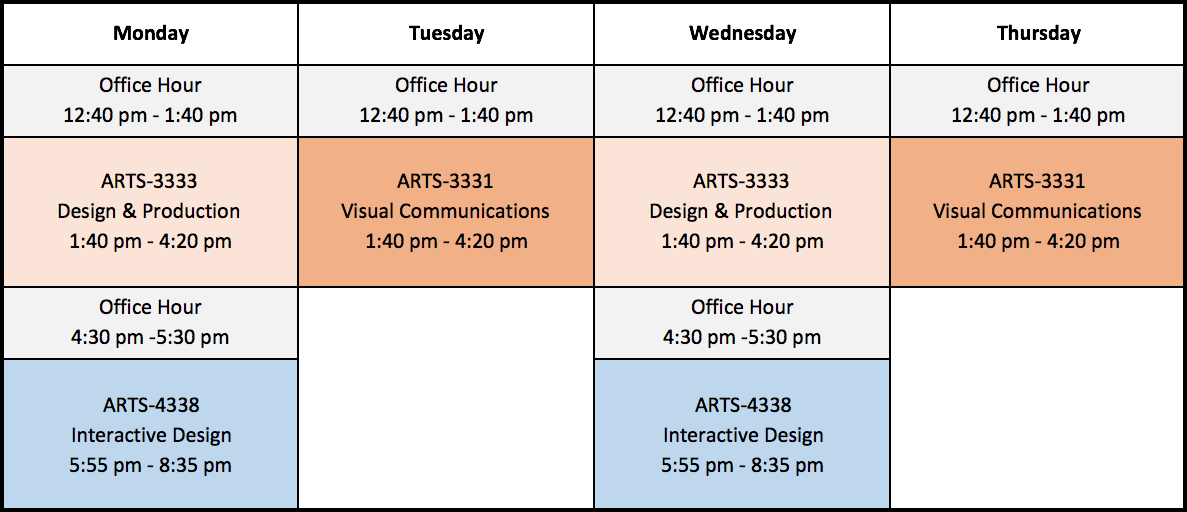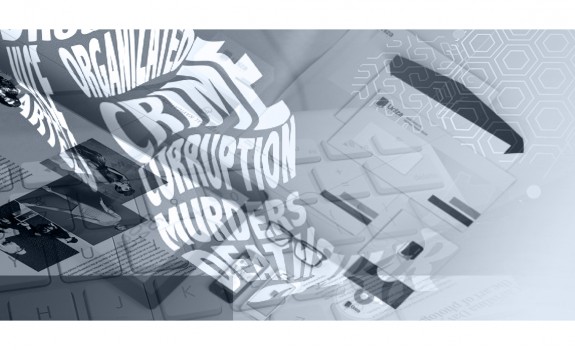ARTS-3331 / Visual Communications – Spring 2016 | TR / 1:40 – 4:20 p.m.
Instructor: Ping Xu
Classroom: VABL – 1.112
Office Location: VABL – 1.209
Office Hours_MW: 12:40 – 1:40 p.m. / 4:30 – 5:30 p.m.
Office Hours_TR: 12:40 – 1:40 p.m.
or by appointment
Phone: 956-665-7500 (Office)
E-mail: ping.xu@utrgv.edu
Course Blog: http://pxstudio.us/blog/?cat=58
Download the print copy of course syllabus
Catalog Description:
This course will explore the translation of verbal language into visual language through a variety of media. The course introduces basic design concepts including the use of image, symbol and color in visual communication, as well as the principles of typographic composition, message structure, and human perception. Design and problem solving focusing on transformation of visual elements into icons, logos, typography technique, and graphic agitation.
Description of Instructional Methods
The structure of the class includes lectures, demonstrations, in-class studio activities such as group discussion, peer critique, and project developments. Projects will be assigned and due on the scheduled dates. At the completion of assigned projects, a critique and presentation will take place.
Course Objectives:
- To introduce basic concepts of visual communication.
- To explore visual languages through a variety of media.
- To explore functional environmental graphics.
- To introduce most popular design programs as visual communication tools.
- To apply typographic principles for visualizing layout compositions.
- To develop critical thinking and conceptual visualization for human perception.
The main objective of this course is to coordinate/combine design components such as icons, symbols, words, and images to construct appropriate, comprehensive and meaningful visual experiences.
Student Learning Outcomes:
- Understand the concept of visual language as expressed visual elements.
- Understand the basic methods of digital media.
- Gain knowledge of the materials and equipment relevant to their major.
- Gain creative skills and presentation skills for professional practice and the ability to generate a cohesive body of graphic design products.
- Become familiar with the process of critical thinking and problem solving.
Student Learning Outcomes for UTRGV’s Graphic Design Majors:
Students who complete the Graphic Design Major are prepared to enter the real world as professional graphic designers or as artists who use the tools and effects of communication art. Student designers are trained to successfully manipulate the components and composition of visual art within a framework of concept that targets an audience or purpose, whether that target is commercially based or personal. The design program installs technological knowledge, cultural and his- torical understanding and artistic integrity. To respond critically to works in the arts and humanities. To engage in the creative process or interpretive performance and comprehend the physical and intellectual demands required of the author or visual or performing artist.
Recommended Books:
- Color Inspirations: More than 3,000 Innovative Palettes from the colourlovers.com community (ISBN-10: 1600619452) http://www.colourlovers.com
- The Brand Gap
- Symbol Mini (ISBN-10: 1780671849)
- Logo Mondo (ISBN-10: 1592533957)
- Designing Brand Identity: An Essential Guide for the Whole Branding Team (ISBN-10: 1118099206)
- Typography 35 (ISBN-10: 0062112899)
- New Masters of Poster Design, Volume 2: Poster Design for This Century and Beyond (ISBN-10: 1592537367)
Recommended Resources & Periodicals:
Behance | Communication Arts | Print | HOW | Computer Arts | Baseline
Scholastic Integrity:
As members of a community dedicated to Honesty, Integrity and Respect, students are reminded that those who engage in scholastic dishonesty are subject to disciplinary penalties, including the possibility of failure in the course and expulsion from the University. Scholastic dishonesty includes but is not limited to: cheating, plagiarism, and collusion; submission for credit of any work or materials that are attributable in whole or in part to another person; taking an examination for another person; any act designed to give unfair advantage to a student; or the attempt to commit such acts. Since scholastic dishonesty harms the individual, all students
and the integrity of the University, policies on scholastic dishonesty will be strictly enforced (Board of Regents Rules and Regulations and UTRGV Academic Integrity Guidelines). All scholastic dishonesty incidents will be reported to the Dean of Students.
Students with Disabilities:
If you have a documented disability (physical, psychological, learning, or other disability which affects your academic performance) and would like to receive academic accommodations, please inform your instructor and contact Student Accessibility Services to schedule an appointment to initiate services. It is recommended that you schedule an appointment with Student Accessibility Services before classes start. However, accommodations can be provided at any time.
Edinburg Campus:
Student Accessibility Services
108 University Center
Phone: (956) 665-7005 (Voice),
Fax: (956) 665-3840 (Fax)
E-mail: accessibility@utrgv.edu
Sexual Harassment, Discrimination, and Violence:
In accordance with UT System regulations, your instructor is a “responsible employee” for reporting purposes under Title IX regulations and so must report any instance, occurring during a student’s time in college, of sexual assault, stalking, dating violence, domestic violence, or sexual harassment about which she/he becomes aware during this course through writing, discussion, or personal disclosure. More information can be found at www.utrgv.edu/equity, including confidential resources available on campus. The faculty and staff of UTRGV actively strive to provide a learning, working, and living environment that promotes personal integrity, civility, and mutual respect in an environment free from sexual misconduct and discrimination.
Attendance Policy:
Students are expected to attend all scheduled classes and may be dropped from the course for excessive absences. UTRGV’s attendance policy excuses students from attending class if they are participating in officially sponsored university activities, such as athletics; for observance of religious holy days; or for military service. Students should contact the instructor in advance of the excused absence and arrange to make up missed work or examinations.
Tardiness Policy:
Tardiness is not tolerated in this class. 3 tardies will be counted as an absence. A tardy or absence on a critique/presentation day will result in a grade reduction for that project.
Effort Policy:
Students are expected to keep track of their performance throughout the semester and seek guidance from available sources (including the instructor) if their performance drops below satisfactory levels. Unprepared, late to class, and/or non-participating students will receive a reduced project grade when applicable.
Back-up Policy:
In order to preventing unexpected file damages or disk lose, please back up your important files such as your final project files and your package folder in two different locations/disks. Another data loss prevention is using Time Machine.
Grading Policy
Student works will be assessed for creativity, presentation, and content value, based on professional standards. About the determination of each student’s grade for the course, the consideration is given to the following areas: Attitude, attendance, constructive participation, development of concepts, aptness of thought, originality, composition, construction, curiosity, tenacity, inventiveness, presentation, and technical proficiency in working those assigned projects. Your final grade of the course will be the sum of your project scores then divided by the quantity of projects.
Grade Scale (apply to each project):
Excellence_90 – lOO [A]
Presents extremely imaginative idea and shows excellent technical/presentation skills. The project may also go well above and beyond the parameters of the exercise. Solid class discussions and critique involvement are also involved.
Above Average_80 – 92 [B]
Completes a solid overall development with original thought through the process of project developments. It also shows good
design incite and work ethic. Regular participation in class discussions and peer critiques are also maintained.
Average_70 – 79 [C]
Meets the parameters of the problem, but does not exhibit originality or may be presented in a condition or manner
that does not effectively communicate the goals of the exercise or in essence lacks proper execution
Weak_60 – 69 [D]
Unacceptable_0 – 59 [F]
Point or Grade Deduction:
Three point deduction will be occurred for the grade of a single project by each unexcused absence during the period of project.
One letter deduction will be occurred for the grade of a single project:
• an absence on a critique/presentation day
• an one day delay of the project
Course Drops:
According to UTRGV policy, students may drop any class without penalty earning a grade of DR until the official drop date. Following that date, students must be assigned a letter grade and can no longer drop the class. Students considering dropping the class should be aware of the “3-peat rule” and the “6-drop” rule so they can recognize how dropped classes may affect their academic success. The 6-drop rule refers to Texas law that dictates that undergraduate students may not drop more than six courses during their undergraduate career. Courses dropped at other Texas public higher education institutions will count toward the six-course drop limit. The 3-peat rule refers to additional fees charged to students who take the same class for the third time.
Course Evaluation:
Students are required to complete an ONLINE evaluation of this course, accessed through your UTRGV account (http://my.utrgv.edu); you will be contacted through email with further instructions. Online evaluations will be available Nov. 18 – Dec. 9, 2015. Students who complete their evaluations will have priority access to their grades.
Process Book:
In this course you will be required to have a process book/design idea diary(minimum size 8.5 x 11) for the entire fall session with entries for each assignment and each class meeting. The book should include; sketches, notes, ideas as well as visual inspirations/imagery from magazines, books, etc. (can be copied cut out) – print design that is interesting/inspirational to you.The process book will be counted as a graded component in each one of the assignments that is presented in this session.
Support Materials
Any periodical, book, etc. -represented by photocopies of articles and work sourced material should relate to the content that we are covering during each assignment.
Notes:
All project notes should be easily sourced in your process books
• any test prints or copies should also be included in your books
• all project information/handouts should be filed.
Supplies & Materials:
- Recommended books_available on Amazon
- Process Book_3 ring binder (for organizing research materials and handouts)
- Notebook/Sketch Book/Pen/Marker
- Digital Camera (rent/borrow, or purchase if applicable) [optional]
- Card Reader [optional]
- Disks for back-up/transportation purposes, please choose one or more of the following options):
– Two 16 or 32GB Flash Drives
– DVD Disks
– An External Hard Drive
Topics:
- Icon Design
- Symbol and Logo Design
- CI and VI Design
- Typography Poster
- Advocacy Poster
Applications:
- Adobe InDesign
- Adobe Illustrator
- Adobe Photoshop
Calendar of Activities:
| January 19 | Class Begin |
| January 21 | Project-1 Begin |
| February 18 | Project-2 Begin |
| March 14 – 18 | Spring Break |
| March 24 | Project-3 Begin |
| April 7 | Project-4 Begin |
| April 14 | Drop/withdrawal Deadline; last day for students to drop the course and receive a DR grade. |
| May 5 | Study Day; no classes |
| May 6-12 | Final exams – Schedule is posted at my.utrgv.edu – check your scheduled time on the course blog |

